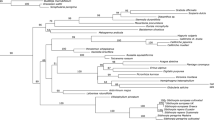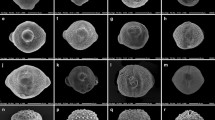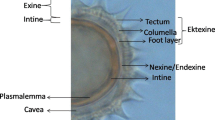Abstract
Leptodermis is a taxonomically problematic genus, and little information about its palynology was known previously. In order to find taxonomic informative characters for species delimitation and their systematic implications, 105 pollen samples, representing 28 species and four varieties, were observed and analyzed. Phylogenetic inference was also conducted based on six chloroplast fragments from 32 taxa to trace the evolutionary trend of pollen characters in Leptodermis. Results showed that two types of pollen can be identified based on the aperture number and position, viz. zonoaperturate pollen with 3 or 4 colpi situated equatorially and pantoaperturate pollen with 6 to 15 apertures evenly spread over the surface forming a polygonal platelike pattern. Pollen polymorphism was rarely observed in a few Leptodermis species. Pollen dimorphism also occurs in Leptodermis, in which the muri are smooth in pollen from pin flowers whereas have minute granules in pollen from thrum flowers. Phylogenetic mapping demonstrated that each of the nine clades matched well with aperture number and position and the 3-colpate condition was plesiomorphic. In Leptodermis, pantoaperturate grains evolved three times independently and were apomorphic. In addition, the frequent occurrence of pollen polymorphism in some species might be explained by shifts among 3-colpate, 4-colpate, and pantoaperturate pollen grains. The pollen-type mapping to the phylogenetic tree revealed that the aperture number and position could well match different phylogenetic clades, suggesting that pollen morphology could provide useful information for taxonomic and systematic studies in Leptodermis.





Similar content being viewed by others
References
Anjum P, Muhammad Q (2007) Pollen flora of Pakstan-Liv. Rubiaceae. Pakistan J Bot 39:999–1015
Backlund M, Bremer B, Thulin M (2007) Paraphyly of Paederieae, recognition of Putorieae and expansion of Plocama (Rubiaceae-Rubioideae). Taxon 56:315–328
Baker HG (1956) Correction: pollen dimorphism in the Rubiaceae. Evolution 10:23–31. https://doi.org/10.2307/2406020
Bremekamp CEB (1966) Remarks on the position, delimitation and subdivision of the Rubiaceae. Acta Bot Neerl 15:1–33. https://doi.org/10.1111/j.1438-8677.1966.tb00207.x
Chen T (2011) Leptodermis. In: Wu ZY, Raven P, Hong DY (eds) Flora of China. Science Press, Beijing, pp 198–211
Chinnappa CC (1981) Palynology and systematics of the genus Coffea. J Coffee Res 11:55–69
Chinnappa CC, Warner BG (1981) Pollen morphology in the genus Coffea (Rubiaceae) and its taxonomic significance. Bot J Linn Soc 83:221–236. https://doi.org/10.1111/j.1095-8339.1981.tb00347.x
Chinnappa CC, Warner BG (1982) Pollen morphology in the genus Coffea (Rubiaceae): ii. pollen polymorphism. Grana Palynol 21:29–37. https://doi.org/10.1080/00173138209427677
Dessein S, Huysmans S, Robbrecht E, Smets E (2002) Pollen of African Spermacoce species (Rubiaceae) morphology and evolutionary aspects. Grana Palynol 41:69–89. https://doi.org/10.1080/001731302760156882
Dessein S, Harwood R, Smets E, Robbrecht E (2005a) Pollen of the Spermacoce (Rubiaceae) species from the Northern Territory of Australia: morphology and taxonomic significance. Austral Syst Bot 18:367–382. https://doi.org/10.1071/SB03025
Dessein S, Ochoterena H, De Block P, Lens F, Robbrecht E, Schols P, Smets E, Vinckier S, Huysmans S (2005b) Palynological characters and their phylogenetic signal in Rubiaceae. Bot Rev 71:354–414. https://doi.org/10.1663/0006-8101
Ganders F (1979) The biology of heterostyly. New Zealand J Bot 17:607–635. https://doi.org/10.1080/0028825X.1979.10432574
Guo XM, Liao Q, Zhou S, Wang RJ (2018) Leptodermis hechiensis (Rubiaceae), a new species from Guangxi, China. Phytotaxa 349:67–72. https://doi.org/10.11646/phytotaxa.349.1.8
Halbritter H, Ulrich S, Grímsson F, Weber M, Zetter R, Hesse M, Buchner R, Svojtka M, Frosch-Radivo A (2018) Illustrated pollen terminology, 2nd edn. SpringerOpen, Switzerland. https://doi.org/10.1007/978-3-319-71365-6
Hesse M, Halbritter H, Weber M, Buchner R, Frosch-Radivo A, Ulrich S, Zetter R (2009) Pollen terminology: an illustrated handbook. Springer, Wien
Igersheim A (1991) Palynological investigations of Paederia L. (Rubiaceae-Paederieae). In: Puff C (ed) Opera Botanica Belgica. National Botanic Garden of Belgium, Meise, pp 135–149
Jansen S, Robbrecht E, Smets E (1996) The systematic value of endexine ornamentation in some Psychotrieae pollen (Rubiaceae-Rubioideae). Grana Palynol 35:129–137. https://doi.org/10.1080/00173139609429074
Johansson JT (1987) Pollen morphology of the tribe Morindeae (Rubiaceae). Grana Palynol 26:134–150. https://doi.org/10.1080/00173138709429943
Johansson JT (1993) Pollen morphology in Psychotria (Rubiaceae, Rubioideae, Psychotrieae) and its taxonomic significance. A preliminary survey. Nordic J Bot 13:32. https://doi.org/10.1111/j.1756-1051.1993.tb00004.x
Lewis WH (1965a) Cytopalynological study of African Hedyotideae (Rubiaceae). Ann Missouri Bot Gard 52:182–211. https://doi.org/10.2307/2394868
Lewis WH (1965b) Pollen morphology and evolution in Hedyotis subgenus Edrisia (Rubiaceae). Amer J Bot 52:257–264. https://doi.org/10.2307/2439937
Liao Q (2015) Biogeography of Leptodermis (Rubiaceae). MSc Thesis, University of Chinese Academy of Sciences, Guangzhou
Lloyd DG (1979) Evolution towards dioecy in heterostylous populations. Pl Syst Evol 131:71–80. https://doi.org/10.1007/BF00984123
Lo HS (1999) Leptodermis wall. In: Chen WQ (ed) Flora Reipublicae Popularis Sinicae. Science Press, Beijing, pp 120–153
Lu JL, Kuang YF, Liao JP (2010) Pollen morphology of Paederia L. (Rubiaceae) from China. J Trop Subtrop Bot 18:491–496
Ma QX, Wang RJ, Chen BH (2005) Pollen morphology of Spiradiclis BI. (Rubiaceae). J Trop Subtrop Bot 13:159–166
Mathew PM, Philip O (1983) Studies in the pollen morphology of South Indian Rubiaceae. In: Nair PKK (ed) Advances in pollen spore research. Tomorrow’s Prints & Publishing, New Delhi
Naiki A, Nagamasu H (2003) Distyly and pollen dimorphism in Damnacanthus (Rubiaceae). J Pl Res 116:105–113. https://doi.org/10.1007/s10265-002-0075-1
Persson C (1993) Pollen morphology of the Gardenieae-Gardeniinae (Rubiaceae). Nordic J Bot 13:561–582. https://doi.org/10.1111/j.1756-1051.1993.tb00101.x
Reshetova SA, Solodukhina MA, Yurgenson GA (2015) The interrelation between pollen abnormalities and polymorphism and the increased contents of toxic elements in flowers and flower buds in Aconogonon angustifolium (Pall.) Hara. and Papaver nudicaule L. Russ J Ecol 46:36–42. https://doi.org/10.1134/s1067413615010142
Robbrecht E (1982) Pollen morphology of the tribes Anthospermeae and Paederieae (Rubiaceae) in relation to taxonomy. Bull Jard Bot Natl Belg 52:349–366. https://doi.org/10.2307/3667888
Rydin C, Bremer B (2009) Evolutionary relationships in the Spermacoceae alliance (Rubiaceae) using information from six molecular loci: insights into systematic affinities of Neohymenopogon and Mouretia. Taxon 58:793–810
Stoffelen P, Robbrecht E, Smets E (1997) Pollen morphology of Coffea and Psilanthus (Rubiaceae-Coffeeae), mainly from Africa. Grana 36:313–327. https://doi.org/10.1080/00173139709362625
Verellen J, Smets E, Huysmans S (2004) The remarkable genus Coptosapelta (Rubiaceae): pollen and orbicule morphology and systematic implications. J Pl Res 117:57. https://doi.org/10.1007/s10265-003-0128-0
Vuilleumier BS (1967) The origin and evolutionary development of heterostyly in the angiosperms. Evolution 21:210–226. https://doi.org/10.2307/2406670
Walker JW, Doyle JA (1975) The bases of angiosperm phylogeny: palynology. Ann Missouri Bot Gard 62:664–723. https://doi.org/10.2307/2395271
Winkler H (1922) Monographische Übersicht der Gattung Leptodermis. Repert Nov Spec Regni Veg 18:145–166
Wolff D, Liede-Schumann S (2007) Evolution of flower morphology, pollen dimorphism, and nectar composition in Arcytophyllum, a distylous genus of Rubiaceae. Organisms Diversity Evol 7:106–123. https://doi.org/10.1016/j.ode.2006.02.005
Xie L, Li LQ (2012) Variation of pollen morphology, and its implications in the phylogeny of Clematis (Ranunculaceae). Pl Syst Evol 298:1437–1453. https://doi.org/10.1007/s00606-012-0648-y
Acknowledgements
We would like to thank Ping Yang and Gangtao Wang from SCBG for help in the field. We are grateful to Ms. Xiaoying Hu and Ms. Xinlan Xu from SCBG for technical assistance with electron microscopy, the curators in HIMC, HNWP, IBSC, LZU for permission to remove pollen from herbarium specimens. We thank Dr. Elmar Robbrecht from Meise Botanic Garden, Dr. Bine Xue, and Prof. Fengxia Xu from SCBG for their helpful comments on earlier versions of the manuscript. This work was financially supported by the National Nature Science Foundation of China (30770156) and Strategic Priority Research Program of Chinese Academy of Sciences (XDA13020602).
Author information
Authors and Affiliations
Corresponding author
Ethics declarations
Conflict of interest
All authors declare that they have no conflict of interest.
Additional information
Handling Editor: Thais N. C. Vasconcelos.
Publisher's Note
Springer Nature remains neutral with regard to jurisdictional claims in published maps and institutional affiliations.
Electronic supplementary material
Below is the link to the electronic supplementary material.
Information on Electronic Supplementary Material
Information on Electronic Supplementary Material
Online Resource 1. Voucher information: Location, voucher No., herbarium, GenBank accession numbers.
Online Resource 2. Alignment used to generate the phylogenetic tree.
Rights and permissions
About this article
Cite this article
Guo, X., Liao, Q., Guo, X. et al. Pollen morphology of Leptodermis (Rubiaceae) and its systematic implications. Plant Syst Evol 306, 15 (2020). https://doi.org/10.1007/s00606-020-01641-3
Received:
Accepted:
Published:
DOI: https://doi.org/10.1007/s00606-020-01641-3




